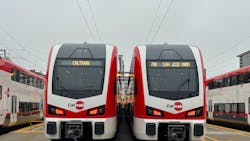Caltrain debuts electric train service with VIP tour
Caltrain debuted its electric fleet on Aug. 10 by hosting a VIP tour where participants boarded the trains for its historic inaugural service.
The event included a 30-minute round-trip experience, starting in San Francisco, Calif., with the opportunity to engage with federal, state, local elected officials, as well as transportation, business, labor and community leaders. The electric trains ran their first regular service on Aug 11. Additional electric trains will be introduced every week until the launch of the new schedule and full electrified service between San Francisco and San Jose, Calif., on Sept. 21.
“The future of California’s rail systems will be powered by clean, renewable energy and as the Biden-Harris Administration makes the biggest investment in public transit in U.S. history, we were proud to help fund the transformative Caltrain electrification project,” said U.S. Department of Transportation Secretary Pete Buttigieg. “Converting the 51-mile-long rail system from diesel to electric will not only improve service for riders and air quality all along the route, it will also set a standard for other rail systems to follow as we work to reduce carbon pollution across the country.”
The new high-performance electric trains offer a better experience for Caltrain riders while providing faster and more frequent service. Express service will allow commuters to travel between San Francisco and San Jose in under an hour. Caltrain notes the new trains will also increase service by 20 percent because they can accelerate and decelerate much faster than diesel trains, providing more robust and flexible access to cities throughout the rail system, with 16 stations seeing trains every 15 to 20 minutes at peak hours and all stations receiving service every 30 minutes on the weekend compared to the current hourly service. Additionally, electrified service will advance equity along the corridor by reducing noise and air pollution while increasing access and service for equity priority communities by 26 percent.
Caltrain notes electrification will help meet ambitious regional and California climate action goals by lowering greenhouse gas emissions, improving air quality and relieving traffic congestion. By transitioning from diesel to electric trains, carbon dioxide emissions will be cut by 250,000 metric tons annually - equivalent to removing 55,000 cars from the road each year. The Electrification Project not only decreases emissions and noise pollution in priority equity communities, but also provides better access and more robust and flexible service for everyone.
The new vehicles offer enhanced amenities, including customer-facing Wi-Fi, new digital onboard displays, power outlets at each forward-facing seat, energy-efficient lighting, an improved climate control system, baby-changing tables in the bathroom, security cameras and expanded storage under the cantilevered seats. They will also generate less noise than their diesel equivalent, making the trip more enjoyable both for riders and residents that live near Caltrain tracks.
“Caltrain’s new electric trains have so many benefits—they are better for the environment, quieter and faster,” said San Francisco Mayor London Breed. “This is an important and necessary step to bringing Caltrain to the Portal in the heart of downtown San Francisco. I am thrilled that passengers from San Francisco all the way down the Peninsula to Gilroy will now be able to enjoy these impressive new trains.”
“The electrification of our railroad has been a goal for decades and it has taken a tremendous effort to make it happen,” said Caltrain Board Chair Dev Davis. “I am delighted for the public to finally see the future of Caltrain for themselves and I invite everyone to get on board and enjoy the next generation of public transit.”
The project has created 33,000 jobs in 36 states, fueling economic growth and innovation within the local communities and throughout the U.S.
“High-speed rail linked to an electrified Caltrain will not just get Californians where they’re going faster, it’s connecting communities and driving economic growth,” said California Gov. Gavin Newsom. “The completed Caltrain project is an integral part of high-speed rail and the story California is telling about clean transportation. And Californians are already seeing the results for themselves as we electrify Caltrain, finish structures, lay track, design and build stations and buy trains. We’re making rail real in California.”
